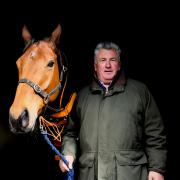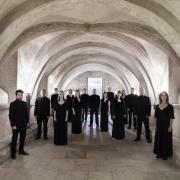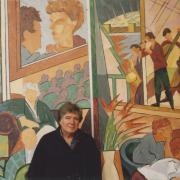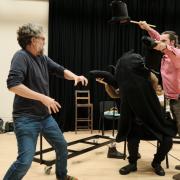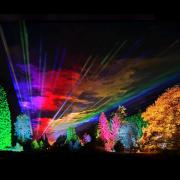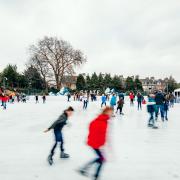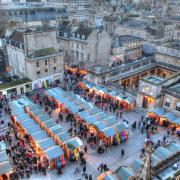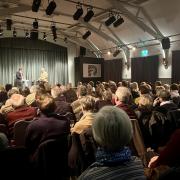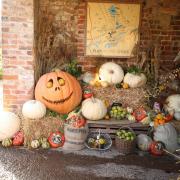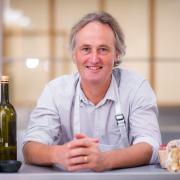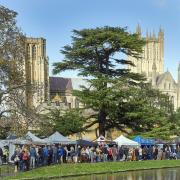Rachael Sharpe meets the internationally-acclaimed and inspirational artist Kirstie Macleod, who has settled in Somerset

Kirstie Macleod’s artwork has its heart in textiles. She describes the medium as the language from which she views the world and can best communicate from, but her work encompasses other diverse genres from film and photography to painting, sculpture, performance, textiles and installation – dictated by what the work invites.
“I don’t see a limit of what’s possible - even if I don’t yet have the skills myself I can learn them,” she explains.
After doing a foundation course at Wimbledon School of Art, a BA in textile design in Bristol and an MA in visual language at Wimbledon School of Art, Kirstie spent nearly 12 years living and working in London.
She moved west to have her son, Skylar, now three, and has lived in Baltonsborough since May 2014.
“We absolutely love it,” enthuses Kirstie who grew up all over the world – she was born in Venezuela and her family moved every three or four years to countries such as Barbados, Nigeria and Japan until coming back to Hampshire, where she went to boarding school.
Identity and the performance of ‘self’ is a big theme in Kirstie’s work, something she returns to again and again – examining and unraveling all the intricacies of what makes us who we are.
These days she tends to work more on paper and in 2D, although the works are built up in a similar repetitive action as seen in sewing.
A real turning point in Kirstie’s career was completing Lacrimosa, an underwater photographic work in the Guernsey Sea. This immensely challenging work saw her wear a dress knitted from 30,000m of fishing line, attached to the seabed.
“The short ‘performance’ saw me in a cyclical battle with the dress - trying to swim up to the surface but continually being pulled down,” says Kirstie who survived using oxygen from divers close by!
The work was inspired by the historical numerous deaths of sailors in the seas around the island, with their only identification being from their Guernsey jumpers; unique in patterning and design to each family/parish.
Another of Kirstie’s pieces that centered on a dress and perhaps the piece for which she’s best known is Barocco.
“I was commissioned by Art Dubai and sponsored by the British Council to create a work for Dubai’s 2009 Art Fair.
“Through subsequent research into the country’s social, political and textile heritage, I learned of its involvement in the silk trade and its opulent, richly coloured garments covered with intricate embroidery.
“Other points of interest were the country’s history of pearl diving, and its very strong religious and social beliefs and values. I was challenged by the dominant patriarchal systems - and even had restrictions placed on me as an artist and what I could and couldn’t depict in the work,” she adds.
Taken from the ancient Portuguese word for a rough or imperfect pearl, Barocco is a performance piece where Kirstie herself sits within a central Perspex cube wearing and embroidering the ornate red dress that fills the tiny space around her.
“By putting the performance inside a transparent cube the audience is invited to examine the work in a different way.
“Is she an ‘object’? Is she confined and trapped inside - or is she actually protected and safe?” she explains.
In the seven years since the first performance, the dress has travelled around the world being continuously embroidered and added to, by 50 different participants to date. The dress has been worked on by female refugees in Palestine, Bedouin in the Sinai mountains, and talented individuals from countries such as South Africa and Tobago alongside creatives in Paris, India and Wales.
Since moving to Somerset the most prominent piece Kirstie has created is her Murmur series - depictions of starling murmurations using embroidered lines of sound-wave like marks.
As well as working on Barocco – Kirstie is currently getting parts of it ready to send off to Kashmir and to a small mountain village in Vietnam - she’s busy with a few other projects too.
Kirstie is working with a retreat just outside of Bruton, on a series of solargraphs installed around the land. There are 12 pinhole cameras in total, fixed around the space - each being exposed for a varying number of lunar months, ranging from one to a year, to create images from the light of the sun.
“The resulting photographs should be rather beautiful, with the Somerset landscape in muddy focus underneath lines of sun trails. “It’s exciting as I have so little control over the final works - the images being created by the weather, temperature, humidity and of course time,” she says.
Funding dependent, Kirstie is also busy preparing a film work examining the various elements involved in tweed production on the Isle of Harris.
“I spent some time there with my father on an ancestral journey and was blown away by the fabrics cultural importance and place in history, society and tradition,”
Kirstie talks about her settling in Somerset as feeling immediately like she’d ‘come home’.
“The landscape and sense of space is so very nourishing, the people are friendly and relaxed with different values to those living in a city.
“I love living alongside and with nature and am continuously blown away by the starlings and the beautiful sunsets outside my house.”
Kirstie praises Somerset for its creative energy, artists, galleries and exhibitions. She feels lucky to be here and we are certainly lucky to have welcomed such a huge international talent into the fold.




